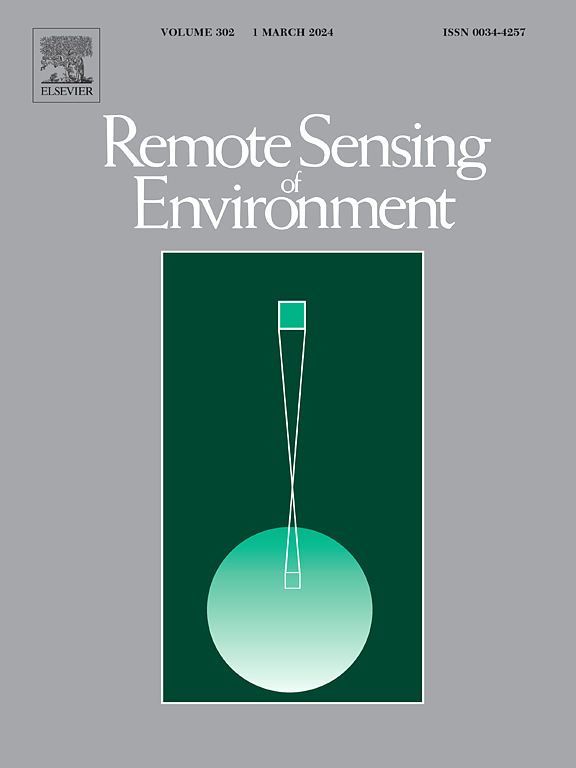Seeing into individual trees: Tree-specific retrieval of tree-level traits using 3D radiative transfer model and spatial adjacency constraint from UAV multispectral imagery
IF 11.1
1区 地球科学
Q1 ENVIRONMENTAL SCIENCES
引用次数: 0
Abstract
Foliage area volume density (FAVD) and leaf chlorophyll content (LCC) are two key traits closely linked to the structure and physiological status of trees. However, their physically-based retrieval at the individual tree level has remained challenging due to the complex interactions of scattering and absorption within the irregularly shaped tree crowns, as well as multiple scattering among neighboring trees, particularly in the near-infrared (NIR) spectrum. In this study, we proposed a tree-specific retrieval strategy that leverages unmanned aerial vehicle (UAV) imagery and corresponding photogrammetric point clouds to establish a tree-specific spatial adjacency constraint within the three-dimensional (3D) RTM-based inversion procedure for each individual tree. Unlike previous approaches that relied exclusively on pixel-level information from the region of interest, the proposed method fully accounted for the multiple scattering from adjacent trees and explicitly incorporates the irregularity of tree crown shapes. In the RTM-based prediction of the spectral reflectance of a focal tree (i.e., the target tree), the structures of adjacent trees were integrated alongside the focal tree, thereby forming a spatial adjacency constraint. This ensures that the scattering regime of the focal tree in the simulated scenario aligns with that of the actual scenario. The proposed method was assessed using both real UAV data and synthetic datasets. The results showed that tree-level retrieval under the adjacency constraint was highly consistent with reference (RRMSE of less than 0.22), whereas retrieval without the adjacency constraint exhibited substantial mis-estimation, particularly for FAVD (RRMSE of up to 0.44). Although the multiple scattering from adjacent trees was primarily influenced by the illumination geometry and tree canopy cover (TCC), sensitivity analysis of the sun zenith angle (SZA) and TCC revealed that retrieval accuracy slightly improved with a decreasing SZA and an increasing TCC. This improvement can be attributed to the enhanced treatment of multiple scattering under these conditions. These findings underscore the effectiveness of the tree-specific retrieval strategy for accurately estimating plant functional traits across forest stands. Moreover, they suggest the potential for monitoring functional diversity and long-term ecosystem process at the forest landscape scale through the use of functional traits.
求助全文
约1分钟内获得全文
求助全文
来源期刊

Remote Sensing of Environment
环境科学-成像科学与照相技术
CiteScore
25.10
自引率
8.90%
发文量
455
审稿时长
53 days
期刊介绍:
Remote Sensing of Environment (RSE) serves the Earth observation community by disseminating results on the theory, science, applications, and technology that contribute to advancing the field of remote sensing. With a thoroughly interdisciplinary approach, RSE encompasses terrestrial, oceanic, and atmospheric sensing.
The journal emphasizes biophysical and quantitative approaches to remote sensing at local to global scales, covering a diverse range of applications and techniques.
RSE serves as a vital platform for the exchange of knowledge and advancements in the dynamic field of remote sensing.
 求助内容:
求助内容: 应助结果提醒方式:
应助结果提醒方式:


